This post may contain affiliate links. Please read our disclosure policy.
How to make delicious, soft homemade cream cheese using a super-simple method and 3 ingredients you probably already have in your kitchen.
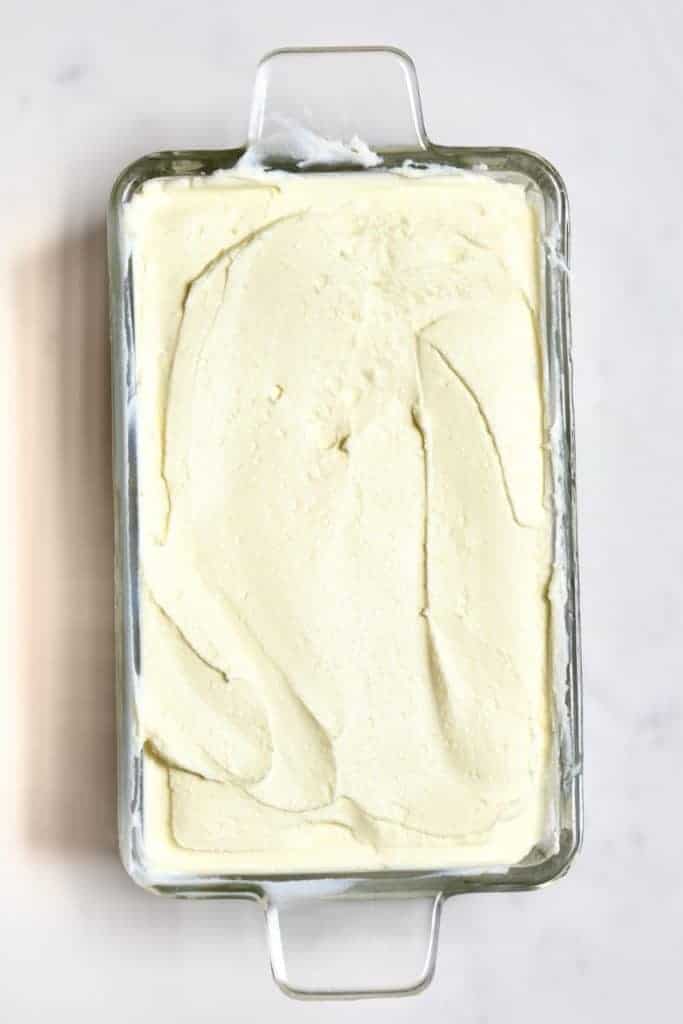
If I’d know how simple it was to make DIY cream cheese, I would have been making it months (if not years!) ago. Somehow I’ve managed to go through DIY’s for DIY Homemade Ricotta Cheese and DIY: Homemade Herb Butter (Compound butter) without trying this simple cream cheese method, which is actually a bit of in-between method of both of them.
In fact, I’m still being surprised at just how many ingredients you can make/get from a single dairy product. Cream cheese, cheese, butter, buttermilk, whey and more.
Smooth and creamy soft cheese only requires three ingredients, that you probably already have; Whole Milk, Lemon Juice and Salt. It can also be customised in any way you’d like – with herbs, pepper, sweet chilli, etc or used for a variety of sweet or savoury purposes.
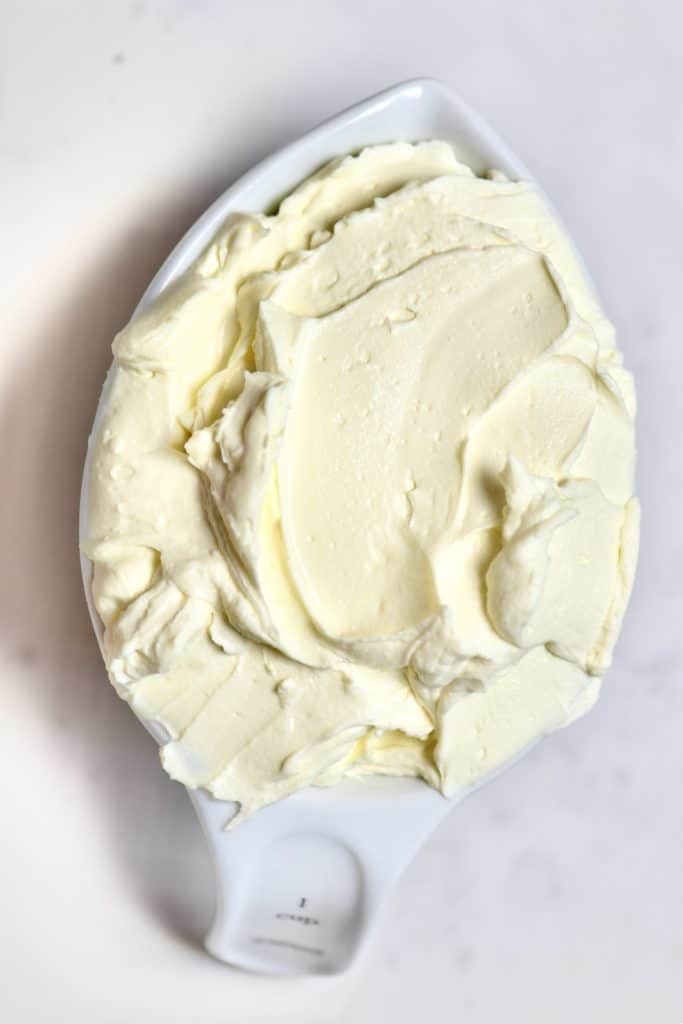
You are able to experiment with the milk used as well: Combining milk and cream in equal parts instead of just using milk, or even using heavy cream alone. Obviously the more cream you use, the richer and ‘creamier’ your final product. However, it would also up the fat levels.
I thought I’d keep things super simple for the first time trying homemade cream cheese and I loved it so much that I didn’t feel the need to complicate or change the recipe in any way.
I have seen recipes for cream cheese using liquid rennet, a cheese culture/starter and more potentially confusing and unobtainable ingredients and that is definitely not ‘my jam’. This is a recipe anyone can do and then can go crazy experimenting with, if desired.
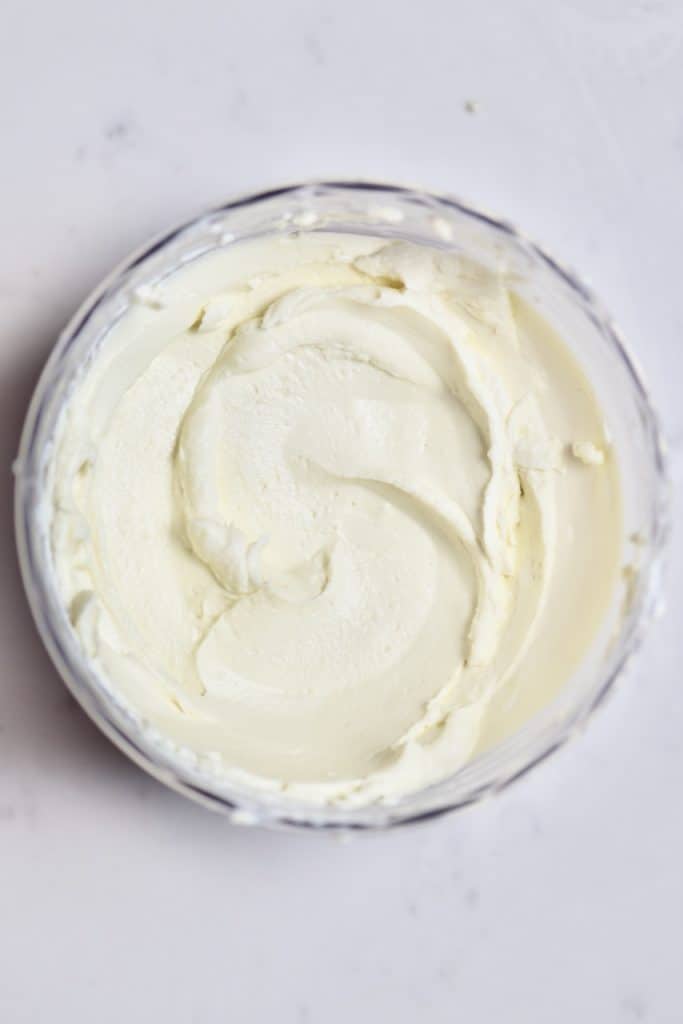
Want to save this recipe?
Why make your own cream cheese?
I know that’s probably a question that some of you are asking, and I actually have the perfect answer. Because homemade cream cheese is SO much better – and I’m not just saying that.
I’m not just talking about taste and texture either. Now, obviously I haven’t tried EVERY cream cheese out there – but last time I was at the store I decided to have a look at the ingredients list of some of the biggest brands of cream cheese here in the UK.
What I found was ‘E’ ingredients, gums and thickeners including the controversial carrageenan! Homemade cream cheese simply uses lemon juice, milk and salt and is still wonderfully smooth and creamy.
As I said above, the method for making cream cheese is actually very similar to making ricotta; Heat your milk, add a coagulant, leave to curdle, drain and blend!
Okay, there’s a little more to it than that, but you get the gist.
The ingredients
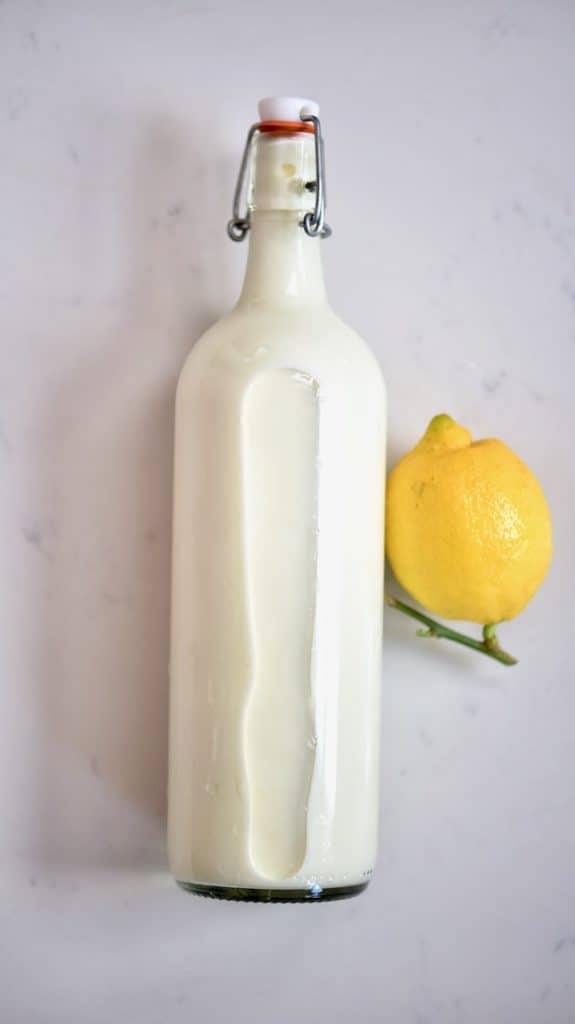
- full-fat milk – it’s important to use full-fat milk because of its fat content.
- lemon
- salt
- optional add-ons – dried herbs, garlic powder, dried chillies
Note* You could alternatively use half whole milk and half heavy cream OR completely use whole cream for soft cheese that is richer/creamier (but with a higher fat content)
You will also need a cheesecloth or a fine-mesh sieve
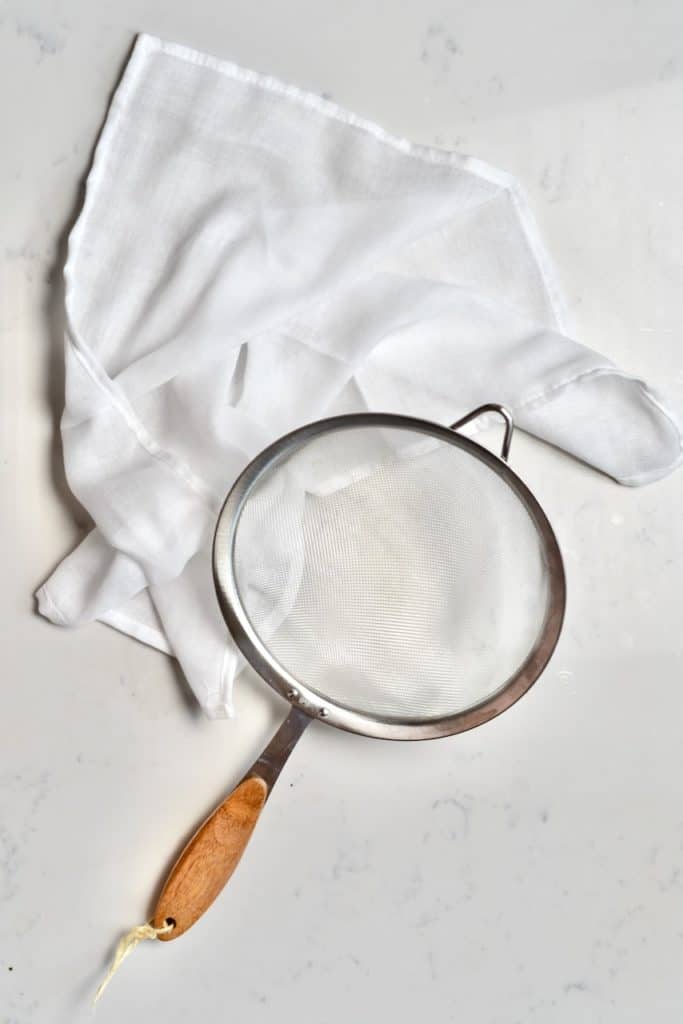
How to make cream cheese
Begin by pouring the milk in a saucepan. Heat the milk and bring it to boil over medium-high heat.
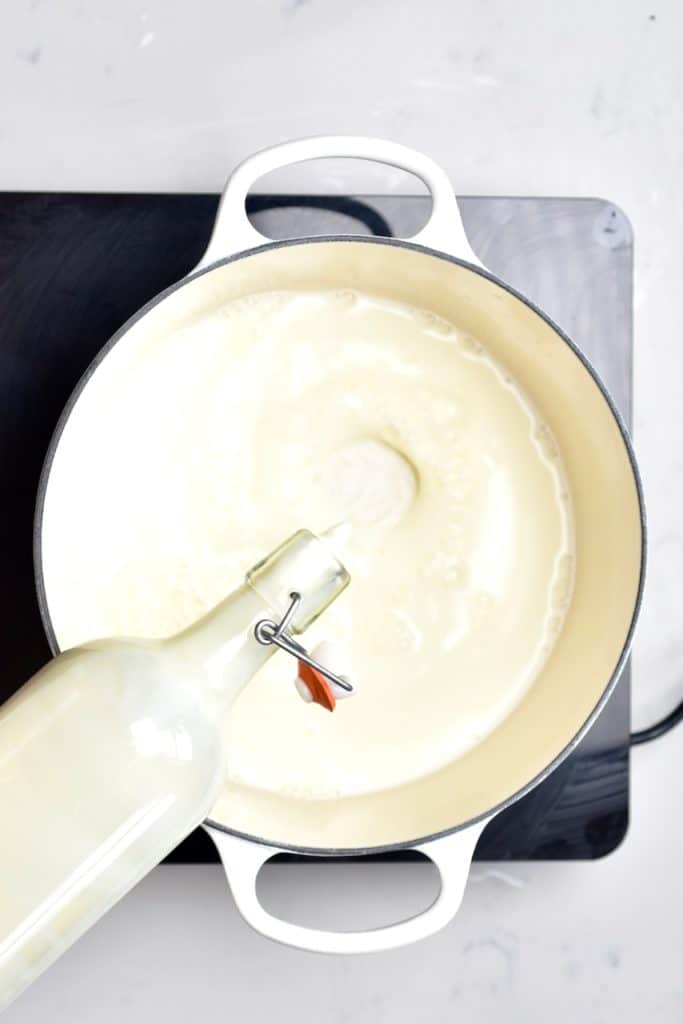
As soon as it boils, add the lemon juice and then turn off the heat.
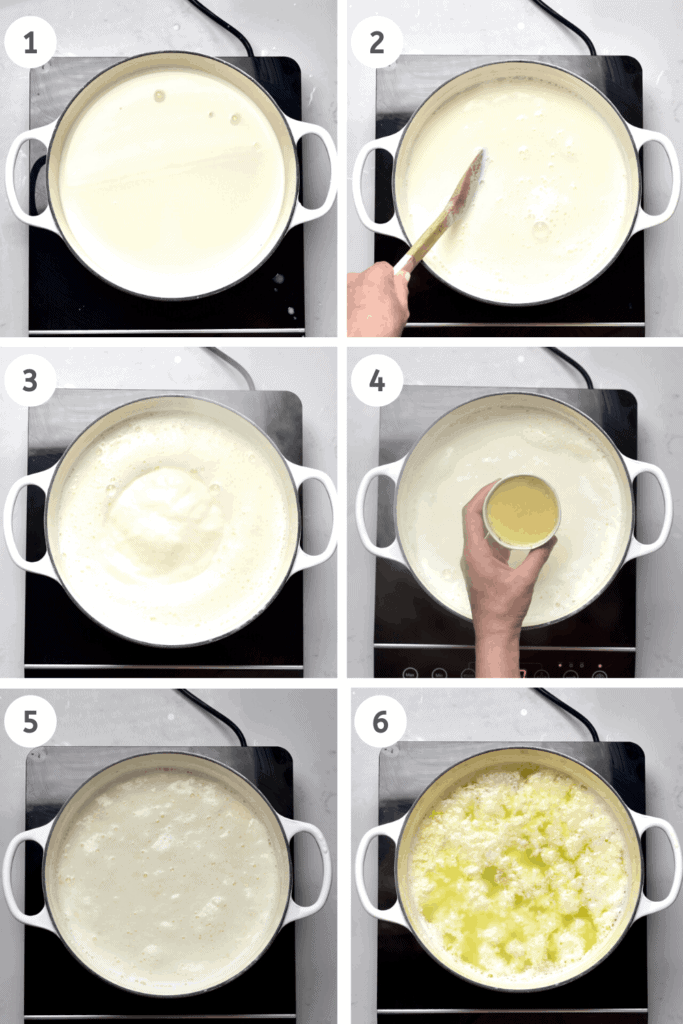
Set aside for a few minutes while the milk curdles. You’ll notice curds forming and a yellow-ish liquid being left behind.
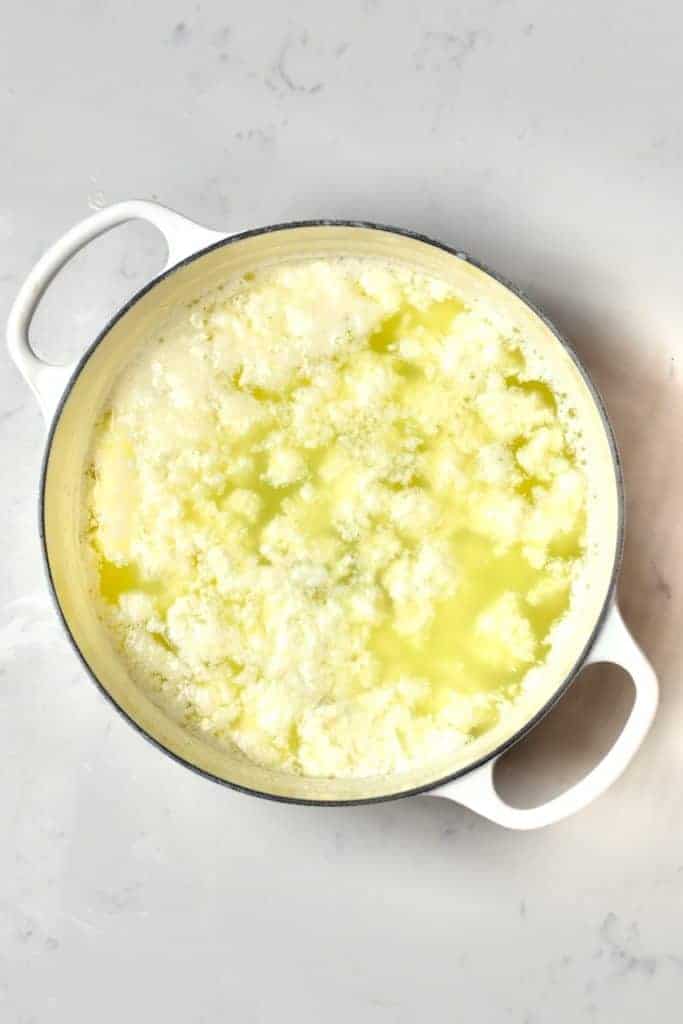
Within a few minutes, all of your curds should have formed. Pour the curdled milk through a cheesecloth and a sieve to strain all the liquid whey.
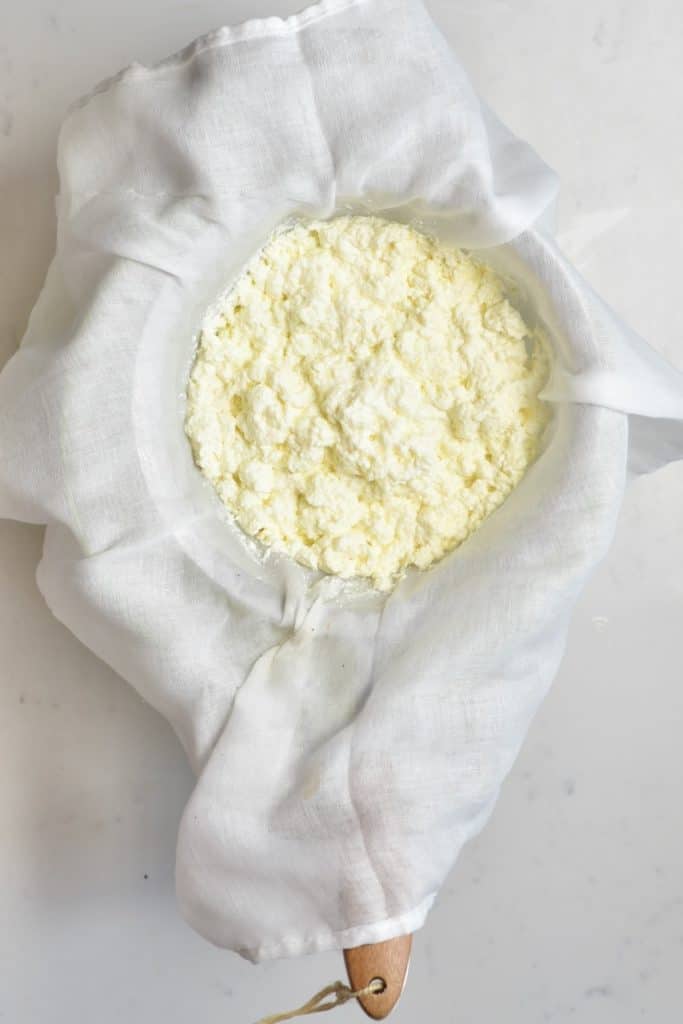
Alternatively, you can use a slotted spoon to scoop out all the curdles, while leaving the liquid whey in the pot.
Note* This leftover whey can then be used in a variety of ways. I’ve talked about this more in my DIY How To Make Paneer At Home post.
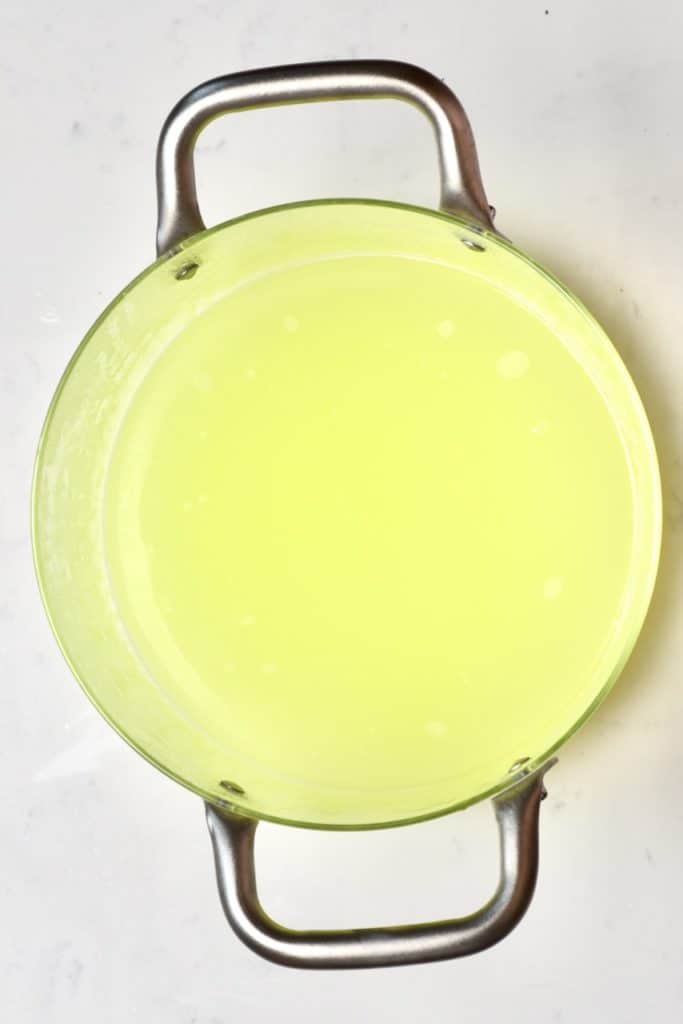
Rinse the curdled milk with cold water by pouring the water over the sieve. This will help to get rid of any extra whey, clinging to the curds.
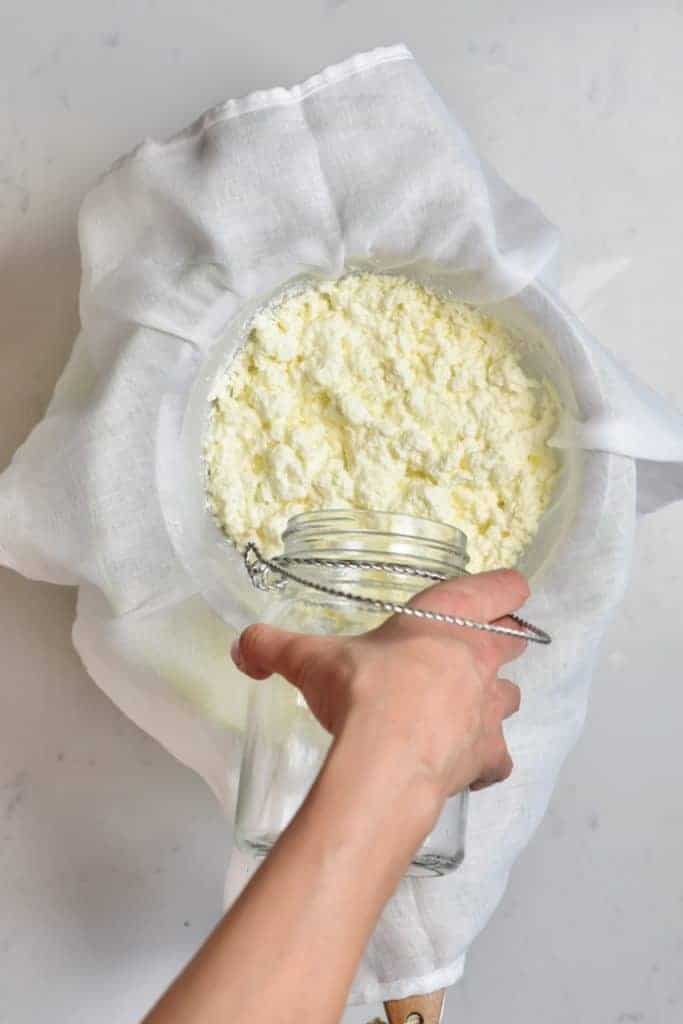
Squeeze the curdled milk as much as possible to drain any last drop of the liquid whey.
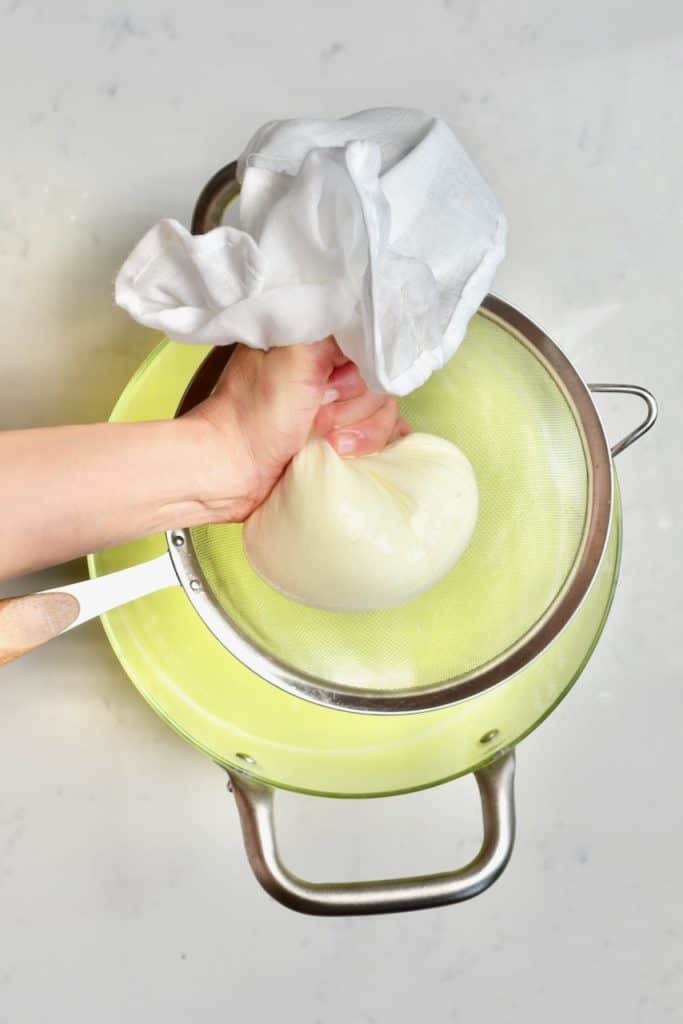
Put the strained milk into a food processor/blender and add the salt.
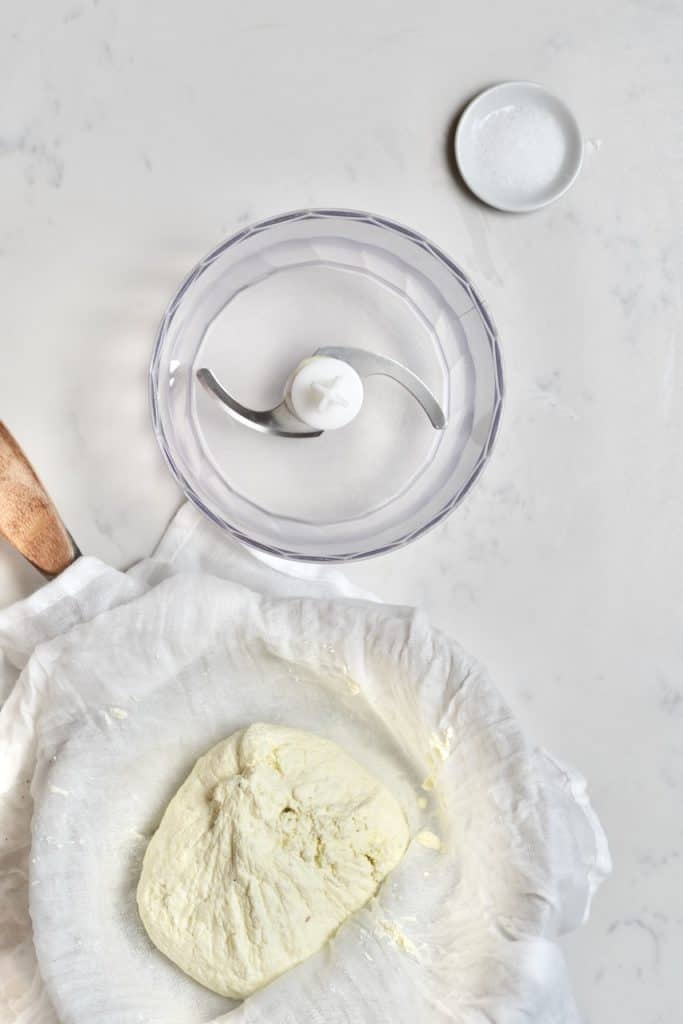
Within 1-2 minutes (this may vary, depending on how powerful your machine is) you’ll have a light and fluffy cream cheese.
If you want to add any additional herbs/flavourings, then do that now too. Be warned though as certain additional ingredients will affect the shelf-life of the cheese. I like dried herbs and garlic powder as natural flavourings that don’t affect the shelf life too much.
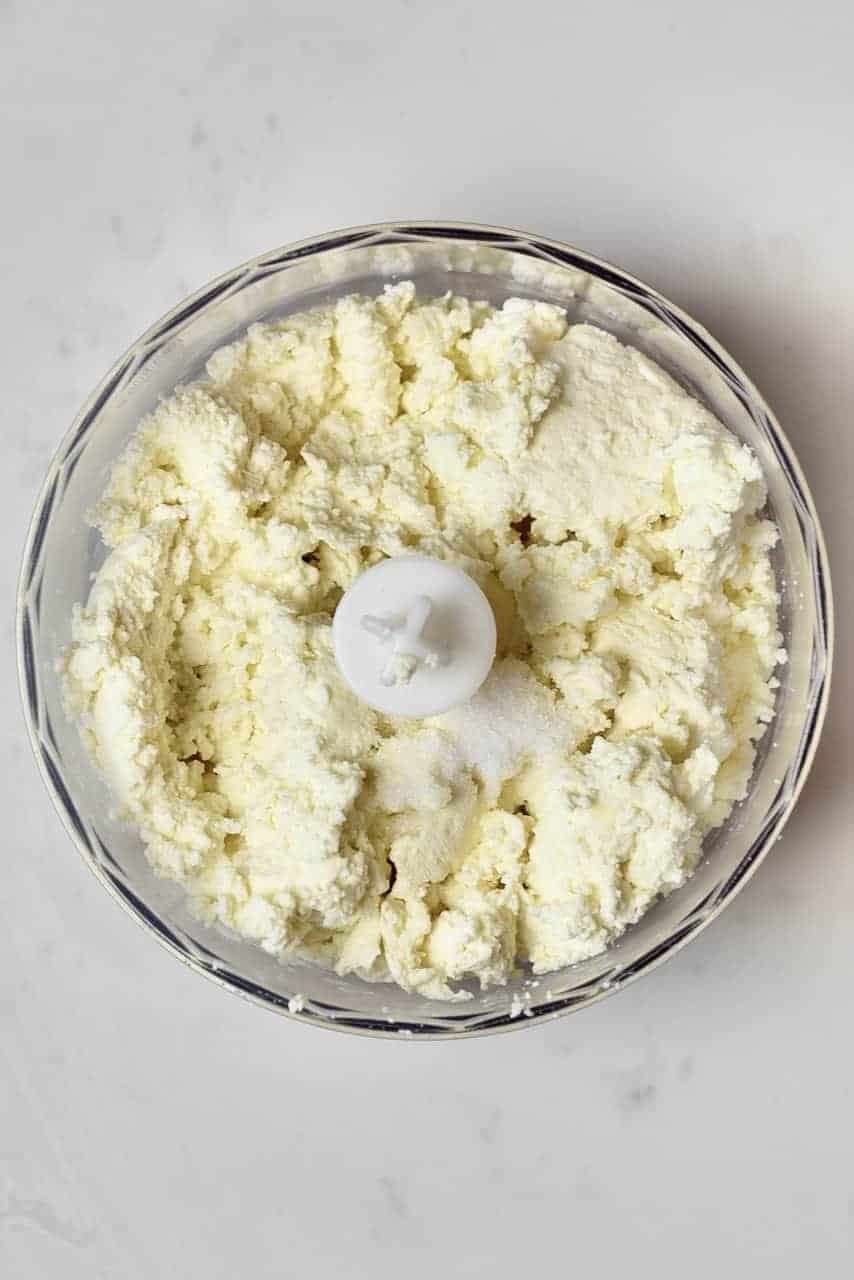
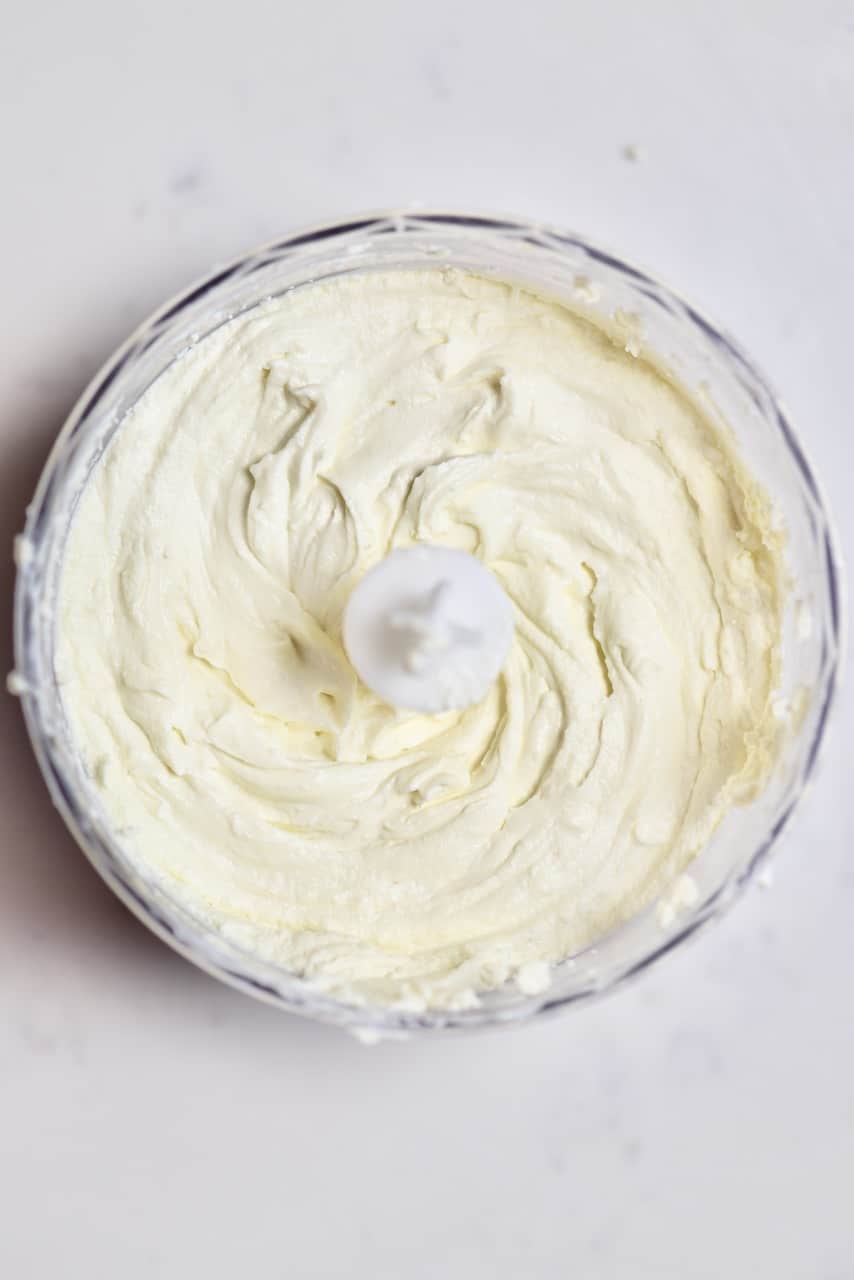
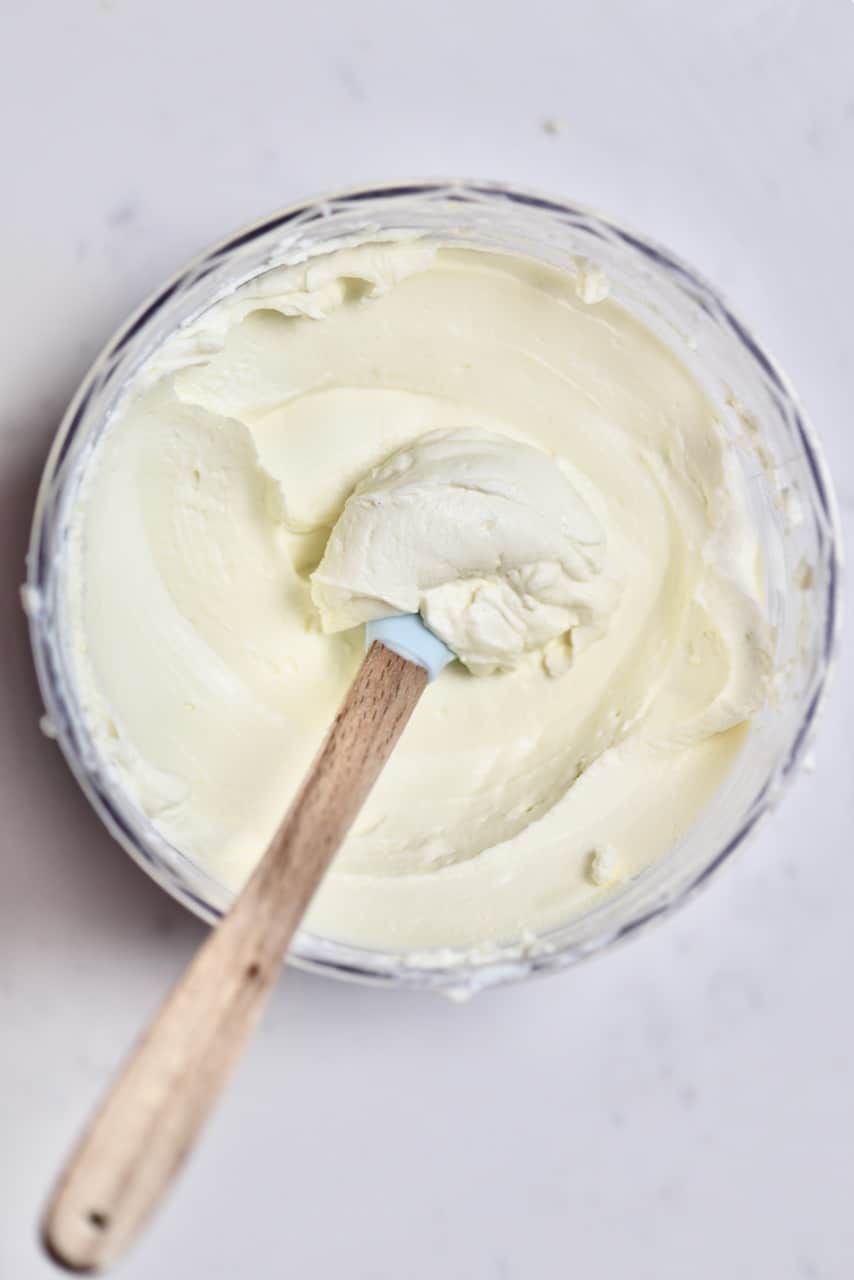
Store the cream cheese in an air-tight container in the fridge for up to 7 days. You can freeze cream cheese, but the texture upon thawing is more crumbly and is best used when you’re cooking it into something like a dip or sauce.
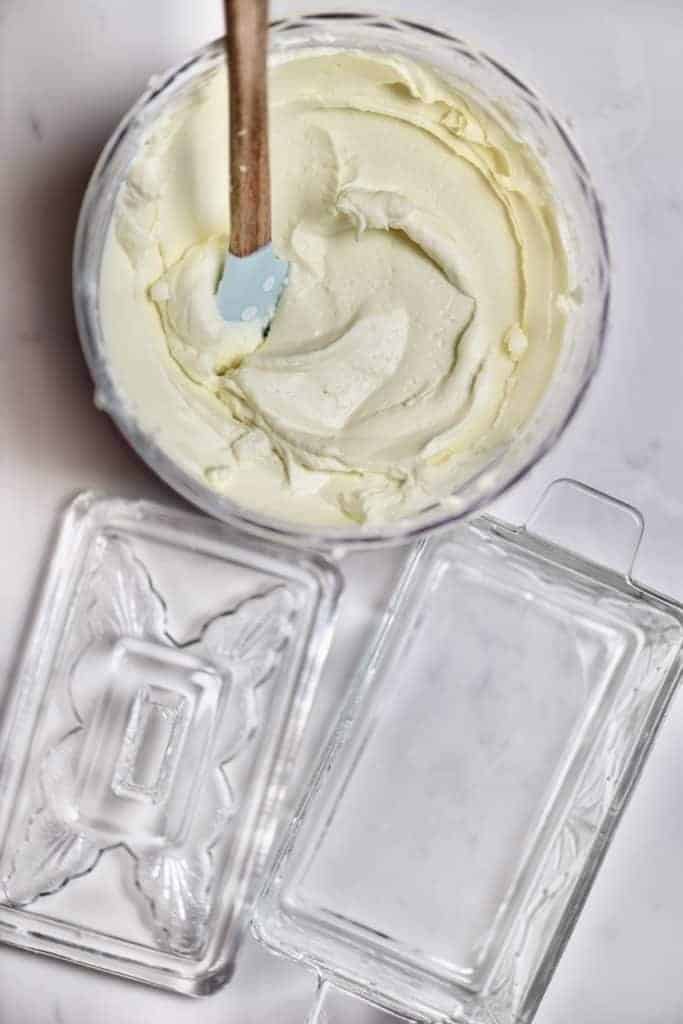
How to eat it?
Once your cheese is ready, then it can be used the same way you would with the store-bought version:
- Spread over a bagel, toast or sandwich
- Added to pasta and other sauces for a delicious creamy twist.
- Blended into a delicious cream cheese frosting (like for this gluten-free banana bread or a carrot cake) or for a cheesecake
- It’s delicious when added to soups and dips, too – like this Moutabal Aubergine Dip
- Spread in pastries.
- As a filling or topping for french toast and pancakes (served along with a berry compote)
And a bazillion (the technical term, of course) other ways.
Other DIY recipes You May Be Interested In:
If it’s DIY’s you’re looking for, then it’s DIY’s you’ve found. I’ve practically got them coming out of my ears. Here is a list of other dairy-based DIYs you may like though.
- DIY Homemade Ricotta Cheese
- DIY How To Make Paneer At Home
- DIY: Homemade Herb Butter ( Compound butter)
- HOW-TO: DIY HOMEMADE NATURAL YOGURT
Vegan Options:
If you’re dairy-free or vegan (or just curious), then you might like these DIYs instead.
- Simple Homemade Vegan Cashew Cheese
- Smoky Vegan Cheddar Cheese
- Herby Vegan Feta Cheese
- Easy Stretchy Vegan Mozzarella Cheese
- How To Make Tofu at Home • Two Simple Methods

Super Easy Homemade Cream Cheese (With Video)
Equipment
Ingredients
- 8 cups whole milk (full-bat) best raw or pasteurized, not UHT
- 5 Tbsp lemon juice or 1 large lemon, or white vinegar
- 1/2 tsp salt or more to taste (optional)
This yield about 1 cup of cream cheese.
Instructions
- Pour the milk into a saucepan. Heat and bring it to a gentle simmer over medium-high heat for 1-2 minutes. Don't let the milk come to a full boil.
- Add the lemon juice. Stir with a wooden spoon to incorporate, and then turn off the heat.
- Set aside for a few minutes while the milk curdles. Curds will form, and the whey (a yellowish liquid) will separate.
- Pour the curdled milk through cheesecloth and a sieve to strain out all the liquid whey. Or use a slotted spoon to scoop out all the curdles while leaving the liquid whey in the pot.
- Rinse the curds with cold water.
- Squeeze the curdled milk as much as possible to drain any last drop of the liquid whey (you can reserve the liquid – see the Notes below).
- Place the strained curdles into a food processor or blender and add the salt. Blend until light and fluffy.If you want it to be more creamy, gradually add 1-2 Tbsp of whey blend until it reaches your desired consistency.Add any optional add-ins now and blend or stir to incorporate them.
- The homemade cream cheese is now ready to enjoy, or you can store it in an airtight container in the fridge for up to 7 days or in the freezer for up to 2 months.
Video
Notes
Nutrition
Nutrition information is automatically calculated, so should only be used as an approximation.


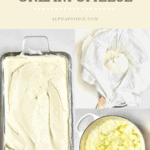
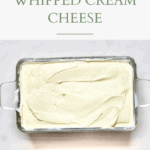
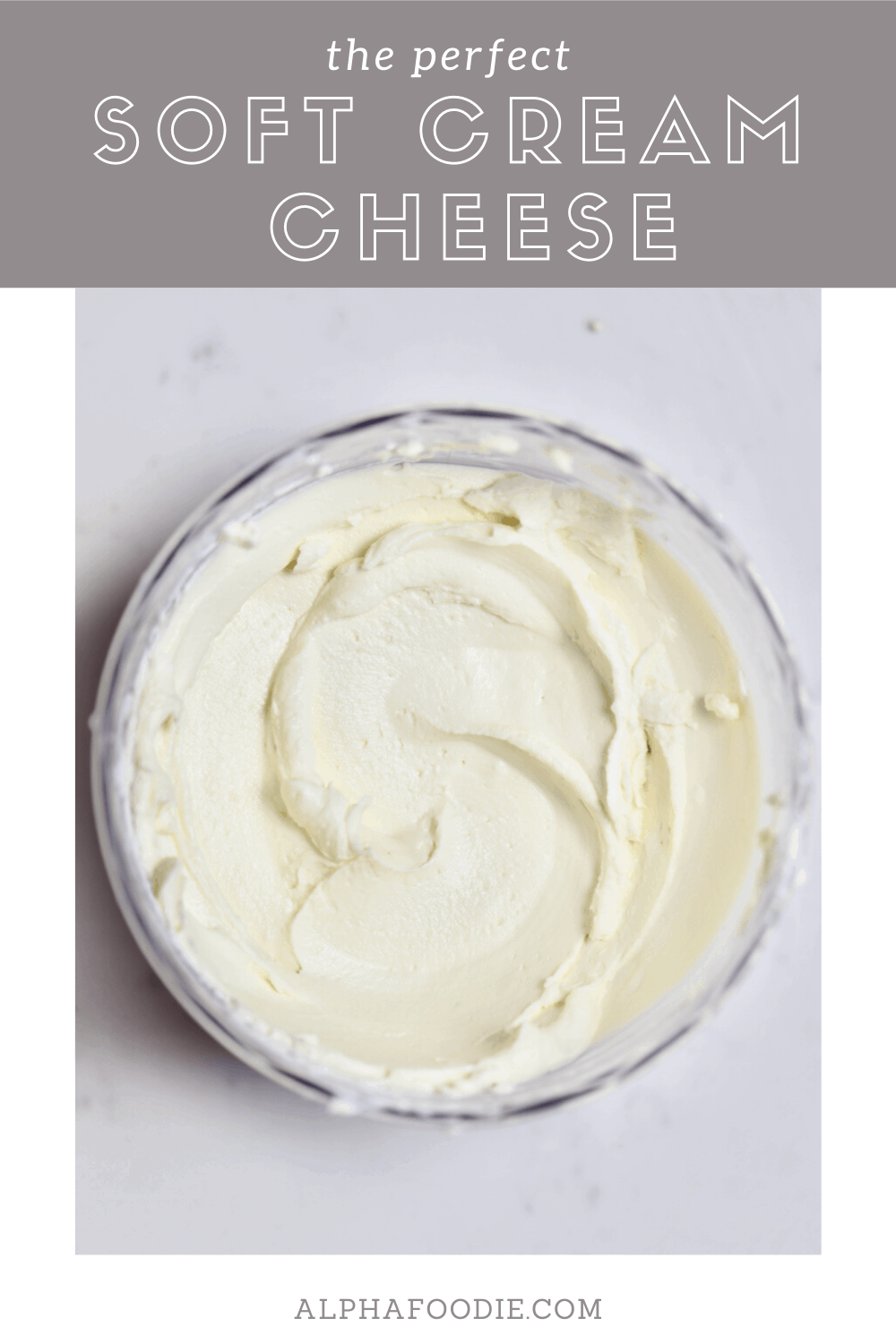









Hey! How many calories would this recipe contain?
Hi, it has about 340 calories per 100 grams! Hope this helps!
Hello,
Just to confirm, I can use ultra-pasteurized milk or cream? I apologize but there are a lot of recipes that you can’t use ultra-pasteurized but they don’t mention that. Thanks!
Hi Mike,
It’s better to avoid using ultra-pasteurized (UP) or utra-high temperature (UHT) milk as it will not form proper curds.
I made this with Lactaid whole milk, which is ultra pasteurized. The curds were small, but I squeezed it really well and it turned out beautifully! My son is so excited for the holiday desserts and dips he has been missing the last 3 years! Thank you!!
Thank you for your comment, Charity. Glad you tried and adjusted the recipe to what works for you.
Can i substitute the lemon juice with white vinegar?
Hi Nove,
Yes, you can use white vinegar instead of lemon juice.
I made it without boiling it or any lemon juice. I used raw milk, drained for 24 hrs in the refrigerator and then again for in the fridge wrapped in cheese cloth for 24 hrs to get the last bit of whey. It was perfect but the taste was really ‘plain’. I just found your site to add salt! Perfection!
Just wanted to add another alternative!
Thank you so much for your comment, Dawn. That’s a great tip.
I tried making it with heavy whipping cream cause that’s what I had and it doesn’t curdled what can I do?
Hi Lizzy,
Unfortunately, just heavy whipping cream can’t make cream cheese. I find it best to just use whole milk (full-fat milk), but there are some recipes in which you can use a part of whole milk, a part of half and half, and a part of heavy cream (I am yet to give this a try).
I tried with whipping cream and 3.25% milk and vinegar instead of lemon juice today. It was a failure! The whey didn’t even separate. I should have followed the recipe exactly for the first try. Next try will be with only homogenized milk and lemon juice. I’m looking forward to the creamy goodness! Thank you for posting this recipe 🙂
Sorry to hear it didn’t work, Kat. Indeed, when using fat-free or low-fat milk, the milk might not curdle at all.
I hope you give the recipe another try. 🙂
Would you be able to do this with a high fat lactose free milk? My husband is lactose-intolerant and I’ve found a store brand of lactose-free cream cheese, but it would be so much better to be able to make my own that he can eat.
Hi Alana,
I haven’t tried it myself, but you should be able to use lactose-free milk for the recipe. I hope you give it a try. Let me know how it goes 🙂
Going to try this ASAP! I live in Cambodia, and while cream cheese can be bought here, it’s either incredibly expensive imported stuff, or locally made but frozen stuff that’s useless for my go-to breakfast (smoked salmon + cream cheese rice cakes!)
I’m wondering if you could do a more Mexican-esque version by using lime juice and adding some chilli, cumin, coriander and oregano. Does the acid have to be lemon juice?
Thanks so much for your comment. I hope you give this recipe a try.
You can definitely use lime juice instead of lemon. And you can also flavor the cream cheese as you like – you can add the spices at the end of blending the cheese. Dried herbs and spices won’t affect the shelf life too much so that’s a plus too 🙂
I just tried it and it was amazing!! Highly recommend.
My only problem is that I used kosher salt and it turned out a little salty but my mom told be to put it in the leftover liquid for a few hours and it fixed it.
So it’s better to use small grain salt instead. I will definitely try this again!
Hi Iman,
I am so glad you like the Cream Cheese recipe. Yes, it’s always best to start with a bit of salt and add more to taste as different types of salt add different levels of “saltiness”. 🙂
hi ,can we make a cheese cake with this cream cheese??? if yes, would’nt it be sour??
Hi Hanna,
I think you can use the homemade cream cheese for a cheesecake. It shouldn’t taste sour since it tastes very similar to store-bought versions (even better, if you ask me 🙂 ). And I am guessing you’d sweeten the cheesecake a bit, so it should turn out well.
Hi
I tried making this recepie but I only used 1/2 litre of milk so can we use 1/2 litre milk with 1 litre fresh cream as hers there is no heavy cream possible and also after I use 1/2 litre milk and made it to cream cheese and kept it in the fridge but then I felt I could have beaten once more so can I or if in the next day i take itback from the fridge and put it in the mixer and grind it again and then i put it in the container and kept it back inthe fridge is it possible to do like that
Hi Aneena,
You only need to use milk. If you use a smaller amount than what I suggest, you would end up with a smaller amount of cream cheese but the taste would be the same. I would suggest using less lemon so that the taste is not lemony.
Once your cream cheese is ready, I think you can mix it again the next day – it will make it smoother. Then just keep it in the fridge as usual. I hope this helps.
Can it be used to make cheesecake?
Hi Suchi,
I think you can use the homemade cream cheese for a cheesecake. 🙂
Hello,
I came across your recipe while figuring out how to get block cream cheese that they have in the States, so I can use it for various US recipes.
Would you say that this recipe is for a spreadable type cream cheese or a block kind?
Thanks,
Liza
Hi Liza,
It is more the spreadable type, perfect for making cream cheese frosting as well. Maybe if you let it drain for longer, you could get a thicker consistency.
I hope this helps.
Hey i dont have a food processor what should i do in that case ?
Hi Preethi,
You can try using a whisk? technically you would want to transform the curds into smooth paste and so a whisk, blender or masher should all achieve this. Hope this helps 🙂
Mine came out so grainy and didn’t taste great. I blended it again with a hand mixer and put it in the fridge….used whole milk….
Hi Katie,
If the milk was overheated, then the protein becomes denatured resulting in a more grainy texture. You can try adding a bit (1-2 tablespoons) of the whey liquid back to the cream cheese and keep blending till you achieve a smooth texture. I hope this helps.